May 30, 2025 | 17:02 GMT +7
May 30, 2025 | 17:02 GMT +7
Hotline: 0913.378.918
May 30, 2025 | 17:02 GMT +7
Hotline: 0913.378.918
Similar to the production of other aquatic species, seaweed seed is the determining key to success, especially with the degraded production environment due to the rising sea temperature. On the other hand, the quality of seaweed varieties is rapidly declining because original varieties are mainly imported, and after extended propagation, the quality of the varieties is severely affected including the growth rate, content and quality. Repetitive vegetative propagation leads to seed degeneration, reducing the growth capacity of the seaweed, reducing quality as well as making it susceptible to diseases.
Many households are currently growing seaweed using natural seeds harvested from ponds and lagoons, and the excessive exploitation of seaweed is quickly exhausting the natural seed source. Seaweed growers in many areas are passive in terms of varieties because they do not have to opportunity to plant and store seaweed all year round.
The cultivation of seaweed seed is also limited due to the competition for marine space with other aquaculture subjects. Seaweed is often grown in the sea adjacent to the shore at a low depth, so that the plant can efficiently photosynthesize sunlight, and farmers can easily take care of the plant. Furthermore, growing seaweed in nearshore waters or inshore lagoons is less expensive in terms of labor and investment costs compared to growing seaweed in offshore waters. However, seaweed farming in nearshore waters face fierce competition in terms of marine space with other aquaculture industries. This is due to the fact that the area of nearshore waters is quickly shrinking due to priority planning for tourism or production of other aquatic species.
According to Mr. Tran Dinh Luan, Director of the Directorate of Fisheries, the Ministry of Agriculture and Rural Development has recently directed various units and branches to prioritize research and development of technology that focuses on restoration, selection and breeding to improve the quality of seaweed seed; support technology transfer, import high quality seaweed species suitable to local ecology.
The Department of Science, Technology and Environment under the Ministry of Agriculture and Rural Development said that during its study of seaweed varieties since 2013, this Department has carried out research on breeding elkhorn sea moss by utilizing the tissue culture method. The research resulted in a pure seaweed variety with carrageenan content as high as 47%, high freezing capacity at 690 - 710 g/cm2, a viscosity of 135Ps, ensuring finished product quality and meeting requirements as raw materials for industrial production.
The functional sector has also established a process to propagate elkhorn sea moss by utilizing the tissue culture method. The results of the application test have shown that the process is effective, contributing to maintaining the growth of carrageenan content, reducing disease infection in seaweed, and maintaining a stable yield. The initial results have exhibited mastery over the technology of seaweed breeding, with the aim of actively improving the production technology process, providing high quality seaweed seed for seaweed growers nationwide, reducing reliance on imported seaweed seed sources.
“The Ministry of Agriculture and Rural Development has promoted the research and application of technology in culturing seaweeds for high yield and carrageenan content in the South Central Coast region, with the aim of selecting high quality seaweed varieties that are suitable to the local ecological conditions. Varieties suitable for the ecological conditions of the South Central region have been selected for further replication. Additionally, the research, experimentation, propagation and development of elkhorn sea moss will be implemented in the Gulf of Tonkin”, said Mr. Tran Dinh Luan.
Vietnam has successfully implemented a model of seaweed farming in Van Don, Quang Ninh. The model was deployed by Super Truong Phat Plastic Group Joint Stock Company on an area of 5 hectares. This model delineates 3 areas: an area for the nursery cage, an area for the floating platform that supports growing seaweed and an area for seaweed drying. Growth rate of seaweed in the model is reported to be 15 to 20% higher compared to that of traditional farming areas in the Central region. It is possible to harvest between 0.5 and 0.7 tons/hectare daily after 45 to 60 days of cultivation. After nearly 3 months of farming and harvesting 20 tons of fresh seaweed, which is equivalent to 2 tons of dry seaweed, the company can supply a production unit with 2,000 tons of seaweed every year. This model has proven that seaweed farming brings excellent livelihood to fishermen in coastal areas if it is developed methodically.
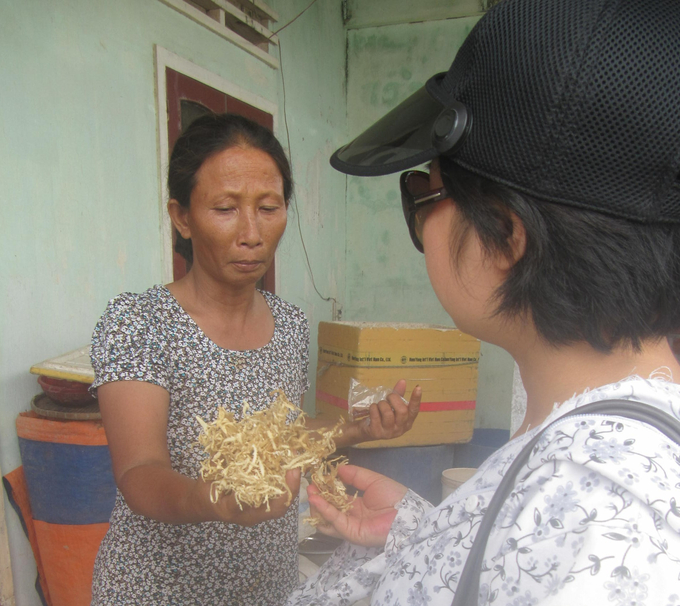
Farmers dry seaweed to sell to traders who come to collect and buy. Photo: V.D.T.
Realizing the potential seaweed industry, the Ministry of Agriculture and Rural Development has developed and promulgated specific regulations, standards, technical norms and production processes for seaweed production. The most notable of which include researching, applying and developing new technologies in growing, processing and extracting micronutrients from seaweed in order to create valuable products, reduce post-harvest losses, and improve production efficiency.
The Ministry of Agriculture and Rural Development plans to strengthen technical training for farmers on seaweed farming and harvesting processes, promote human resource training, and strengthen cooperation between institutes, schools, research institutions and processing businesses to transfer technologies that focus on food, cosmetics and pharmaceuticals made from seaweed. Subsequently, projects on growing, processing and consuming seaweed will be developed to serve as models for localities and businesses to follow, replicate and create spillover effects.
The Ministry aims to gradually form concentrated seaweed growing areas in the direction of specialized cultivation, with sufficient scale to ensure quality and supply seaweed processing factories; Organize production development along the value chain that links production with processing and consumption; Form and develop cooperatives, cooperative groups to grow seaweed and ensure supply for the market's demand.
According to Mr. Tran Dinh Luan, for Vietnamese seaweed develop even further, the Ministry of Agriculture and Rural Development must strengthen international cooperation to share experiences related to seaweed production, harvesting, processing and consumption. Moreover, the Ministry needs to call for technical support and resources from international organizations in Vietnam in developing the export-oriented seaweed industry in association with environmental conservation and sustainable development; Research, share experiences, support the development and promotion of marine products domestically and internationally.
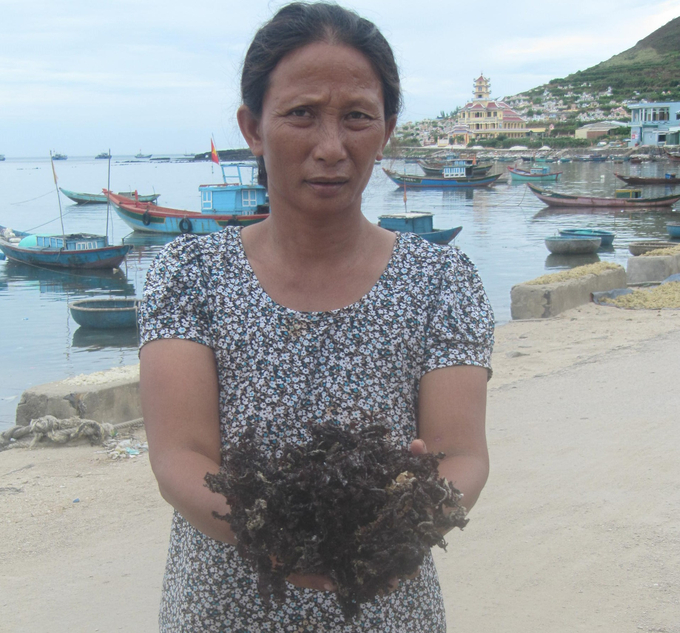
Farmers have mainly grown seaweed using traditional methods, so the production yield is low, and the quality of carrageenan is unstable. Photo: V.D.T.
“We will coordinate with international organizations to participate in activities related to seaweed, to seek opportunities for cooperation, technology transfer and experience in developing the seaweed industry, promoting trade, introducing Vietnamese seaweed products to regional as well as global markets”, said Mr. Tran Dinh Luan.
However, in order to fully capitalize on the potential of the seaweed industry, the government also requires the active participation from localities and businesses. Namely, people living along the coast must be aware that seaweed farming is a self-sufficient livelihood, so that they can develop synchronously.
Farmers have mainly grown seaweed using traditional methods without applying technological advances, so the production yield is low, and the quality of carrageenan is unstable. The technology of harvesting, preserving and handling products post-harvest is still rudimentary, leading to low quality and biomass of seaweed. In addition, the seaweed industry is poorly planned, the production is not synchronized, and the value chain in production and consumption has not been established. These are issues that need to be resolved for the seaweed industry to develop sustainably.
Translated by Nguyen Hai Long
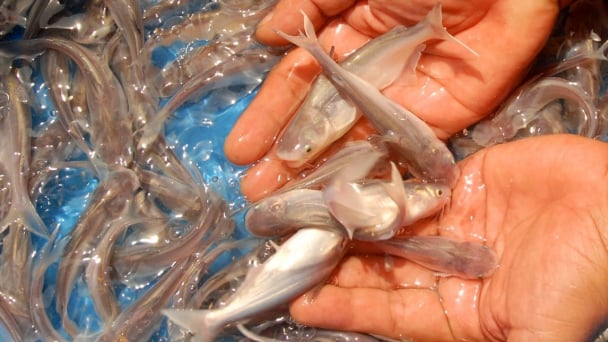
(VAN) Vaccinating juvenile pangasius helps reduce disease, antibiotic use, and farming costs, increasing profits for export-oriented farmers in An Giang.

(VAN) Due to a limited supply of workforce and competitive recruitment requirements, businesses struggle to retain talented veterinary human resources.
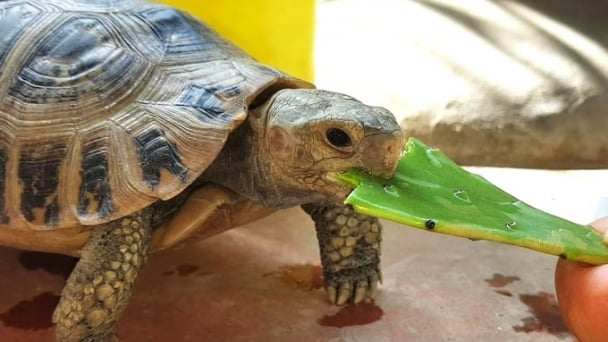
(VAN) WOAH’s guidance aims to mitigate disease risks through a One Health approach that balances economic, conservation, and public health interests.

(VAN) Ms. Nguyen Thi Dung, Deputy Director of Ngoc Hoang Cooperative, shared about the journey of bringing dragon fruit to Europe, achieving annual revenues in the billions of VND.
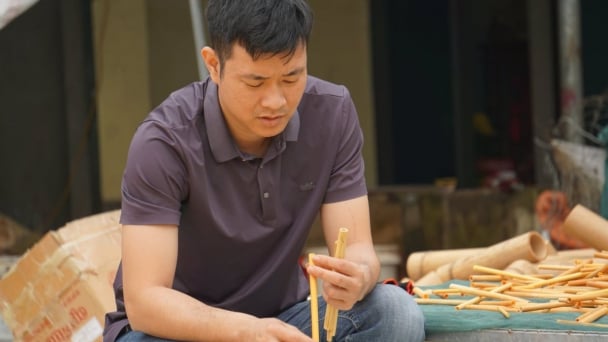
(VAN) Bamboo products from Thang Tho Bamboo Cooperative have reached many countries around the world, while also creating jobs for local workers.
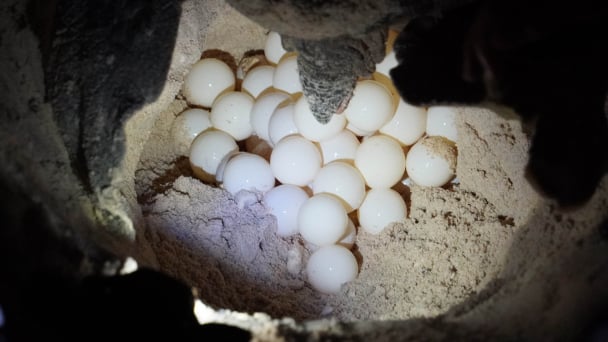
(VAN) The Management Board of Con Dao National Park reported that a green sea turtle, tagged in the Philippines, has traveled thousands of kilometers to lay 84 eggs on Bay Canh Islet.
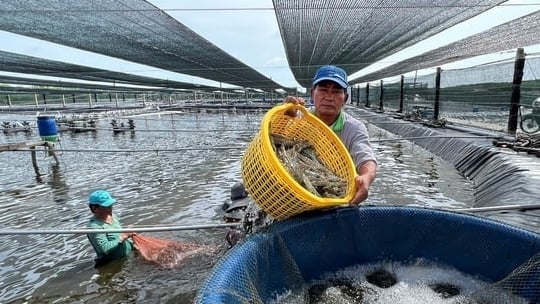
(VAN) Green technology is paving a new path for sustainable aquaculture in the Mekong Delta in particular and across the country in general, helping reduce emissions and adapt to climate change.